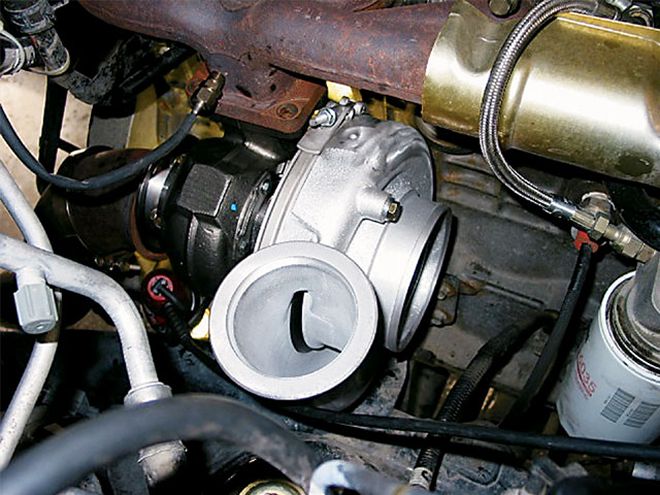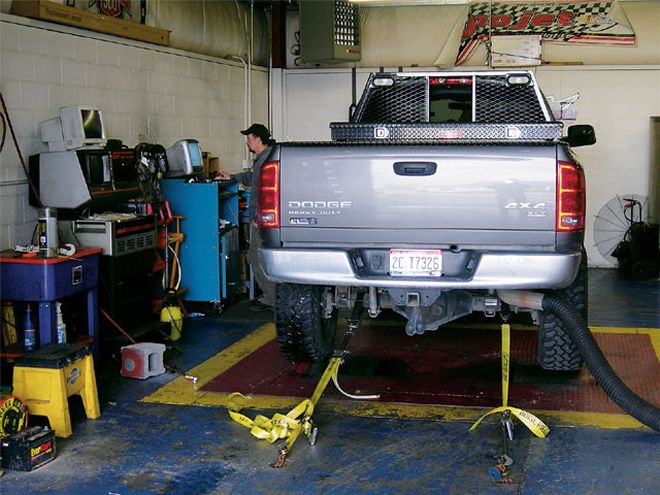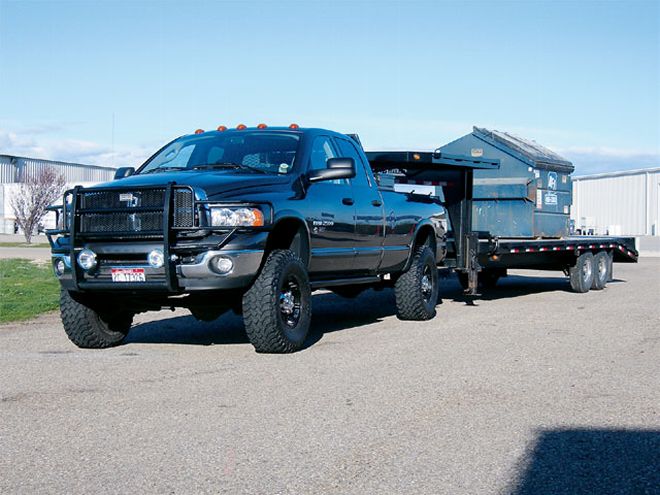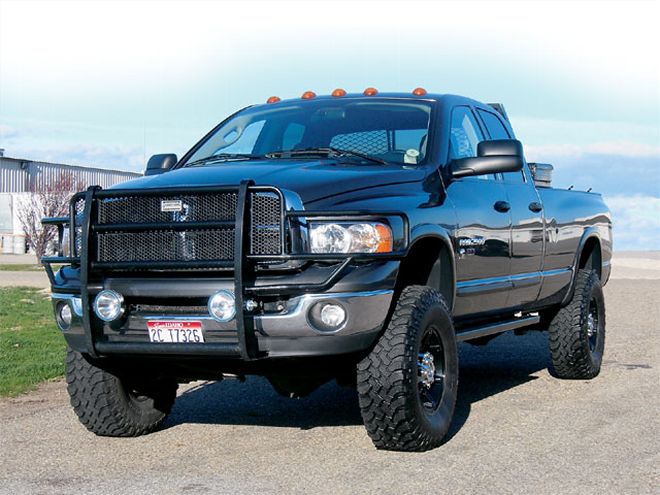
| 2004 Dodge Ram 2500 Cummins front View
A stock Dodge Cummins H.O. comes with plenty of power, but once you succumb to the urge and add big tires and a lift kit, you can be left wishing for more grunt under the hood. Our test vehicle was an '04 Ram that had been saddled with a 4 1/2-inch suspension lift, 37-inch tires, 17-inch wheels, a grille guard, nerf bar side steps, a headache rack, a 40-gallon auxiliary fuel tank, bedrail guards, a bedliner, and a heavy toolbox.
The truck looked great, but all of the added parts had a negative effect on acceleration and towing performance. Plus, we worried the transmission would be prone to failure now that it had to work so much harder. We put together a plan to help the drivetrain catch up to the off-road modifications that were slowing us down. Since our transmission was in danger, we decided to work on it first.
Transmission UpgradesOur stock 48RE slushbox was marginal in handling the power of our unaltered Cummins, so there was no way it would survive the engine modifications we had planned. We contacted ATS Diesel Performance and ordered their Stage V transmission upgrade. It includes a triple-disc torque converter, performance valvebody, billet internals, billet flexplate, a deep pan, and transmission controller. After it was installed, we had much firmer shifts, a lower stall, and the ability to adjust the torque converter lock-up speed. Now we were confident that the transmission would be able to handle the power upgrades we were ready to throw its way.
Engine UpgradesTo attain balanced, durable, efficient, and drivable power, we set about improving the airflow, fuel supply, and engine management. To make sure our Cummins would have plenty of fresh air to breathe after our upgrades, we started by adding a Scotty III cold-air intake hooked to a Uni two-layer oiled foam air filter. This setup gave us lots more airflow than the stock system, but it has the stealth of a factory airbox. We also added a free-flowing performance exhaust system to help air escape the Cummins. Now that the engine could breathe freely and was backed by a sturdy transmission, we felt it was safe to start upgrading the output of the inline-six engine.
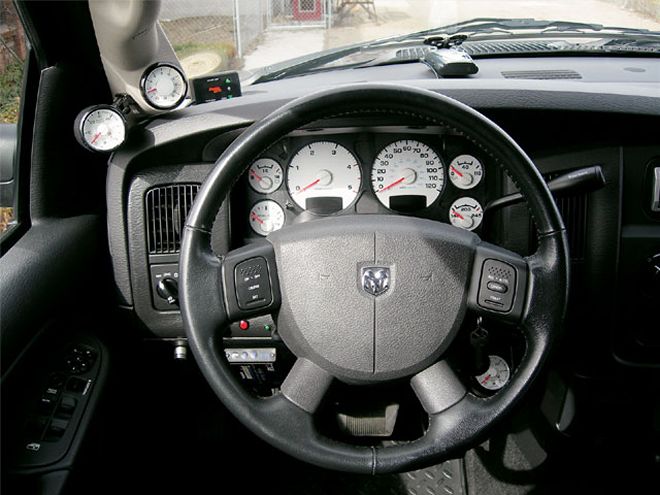
| With all of the added gauges, the cabin of our Ram is beginning to resemble the cockpit of a fighter jet. You can see the PowerMax controller in the upper-left corner of the dash.
First, we added gauges to keep an eye on our exhaust gas temperature (EGT), turbo boost, and the fuel pressure, because what's the point of upgrading the engine if it blows up a week later? Our EGT probe was placed in the manifold (before the turbo), the boost gauge was plumbed into the intake manifold, and the fuel pressure monitor was installed after the fuel filter. We were ready to start dumping more diesel into our Cummins.
To ensure we would have enough diesel available for our next upgrades, we removed the stock lift pump and replaced it with a Scotty Smart Fuel kit. This system includes an upgraded lift pump, along with all the fittings and fuel lines needed. It's designed to provide a constant 12 psi of pressure to the injection pump, which will make sure our engine is not starving for diesel.
First, we installed a TST PowerMax CR to modify the injection timing and the injector duration. It has 10 torque levels at 1,600 rpm and 10 horsepower levels at 2,900 rpm for 100 different possible combinations to fine tune fuel delivery. Each setting affects timing by altering when the injectors open and increasing the duration of time the injectors are spraying. We used the most aggressive program, which is capable of adding up to 190 hp at the rear wheels.
Next, we added a TS Performance Power Play MP-8 module into the mix. It is designed to increase fueling without raising pressure in the rails by reprogramming the MAP sensor and "fooling" the engine computer. At low boost levels, the module tricks the ECM into thinking the turbo is working hard and needs extra fuel. This trickery results in up to 100 extra horsepower from your Cummins-and that's with a stock turbo.
Turbo UpgradesWith plenty of fuel on tap and our engine breathing freely, it was time to bolt-on a new high-performance turbo. We chose the new ATS Aurora 5000. It features a 5-inch compressor inlet and is capable of producing up to 60 psi of boost (the stock turbo is unreliable when asked to produce more than 30 psi). The Aurora 5000 is much larger than the stock turbo, but it spools rather quickly for a unit this size.
Dyno ResultsSince actions speak louder than words, we decided to take our theoretical improvements and see what the dyno wheel had to say. Before the modifications, our Ram riding on 37-inch tires was recording 250 hp and 450 lb-ft of torque at the rear wheels. It was producing 28 psi of boost and the exhaust temperature was 1,400 degrees Fahrenheit.
After a few tuning runs and some turbo break-in time, we put the modified Ram on the dyno. With the new transmission, turbo, lift-pump kit, and power modules, it pulled an impressive 550 hp and 1,050 lb-ft of torque at the rear wheels. During the dyno runs, we recorded 56 psi of boost and recorded a moderate EGT of 1,450 degrees.
The Real WorldSince unstrapping the truck from the chassis dyno, our real-world performance has been exceptional. We've racked up 4,500 miles of sports-car-like acceleration, semi-truck-like towing, and have experienced no penalties in durability.
 | 2004 Dodge Ram 2500 Cummins front View
A stock Dodge Cummins H.O. comes with plenty of power, but once you succumb to the urge and add big tires and a lift kit, you can be left wishing for more grunt under the hood. Our test vehicle was an '04 Ram that had been saddled with a 4 1/2-inch suspension lift, 37-inch tires, 17-inch wheels, a grille guard, nerf bar side steps, a headache rack, a 40-gallon auxiliary fuel tank, bedrail guards, a bedliner, and a heavy toolbox.
The truck looked great, but all of the added parts had a negative effect on acceleration and towing performance. Plus, we worried the transmission would be prone to failure now that it had to work so much harder. We put together a plan to help the drivetrain catch up to the off-road modifications that were slowing us down. Since our transmission was in danger, we decided to work on it first.
Transmission Upgrades
| 2004 Dodge Ram 2500 Cummins front View
A stock Dodge Cummins H.O. comes with plenty of power, but once you succumb to the urge and add big tires and a lift kit, you can be left wishing for more grunt under the hood. Our test vehicle was an '04 Ram that had been saddled with a 4 1/2-inch suspension lift, 37-inch tires, 17-inch wheels, a grille guard, nerf bar side steps, a headache rack, a 40-gallon auxiliary fuel tank, bedrail guards, a bedliner, and a heavy toolbox.
The truck looked great, but all of the added parts had a negative effect on acceleration and towing performance. Plus, we worried the transmission would be prone to failure now that it had to work so much harder. We put together a plan to help the drivetrain catch up to the off-road modifications that were slowing us down. Since our transmission was in danger, we decided to work on it first.
Transmission Upgrades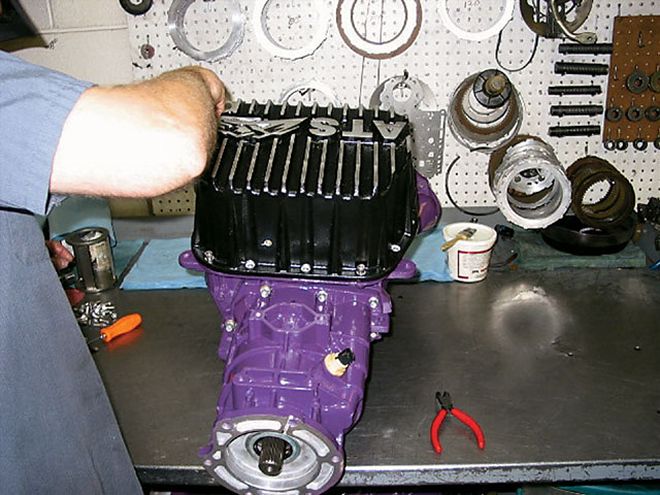
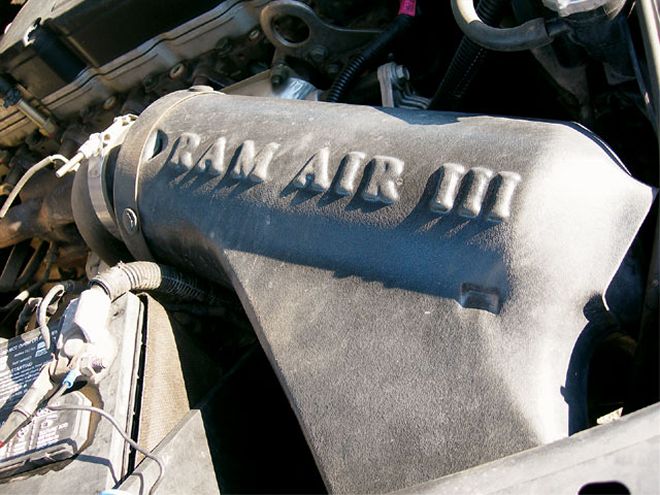
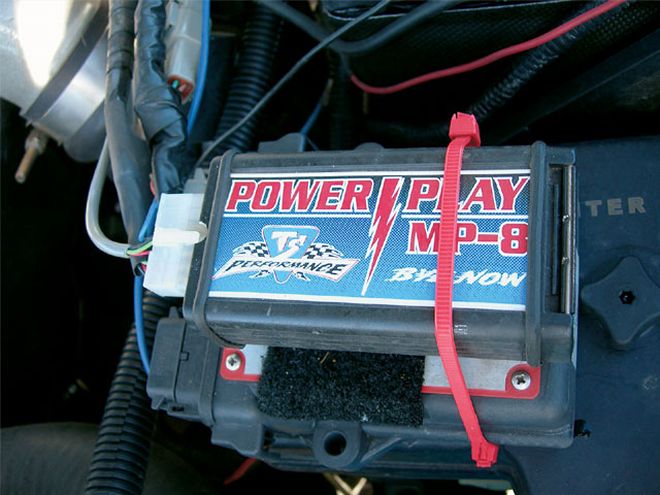
 | With all of the added gauges, the cabin of our Ram is beginning to resemble the cockpit of a fighter jet. You can see the PowerMax controller in the upper-left corner of the dash.
First, we added gauges to keep an eye on our exhaust gas temperature (EGT), turbo boost, and the fuel pressure, because what's the point of upgrading the engine if it blows up a week later? Our EGT probe was placed in the manifold (before the turbo), the boost gauge was plumbed into the intake manifold, and the fuel pressure monitor was installed after the fuel filter. We were ready to start dumping more diesel into our Cummins.
To ensure we would have enough diesel available for our next upgrades, we removed the stock lift pump and replaced it with a Scotty Smart Fuel kit. This system includes an upgraded lift pump, along with all the fittings and fuel lines needed. It's designed to provide a constant 12 psi of pressure to the injection pump, which will make sure our engine is not starving for diesel.
First, we installed a TST PowerMax CR to modify the injection timing and the injector duration. It has 10 torque levels at 1,600 rpm and 10 horsepower levels at 2,900 rpm for 100 different possible combinations to fine tune fuel delivery. Each setting affects timing by altering when the injectors open and increasing the duration of time the injectors are spraying. We used the most aggressive program, which is capable of adding up to 190 hp at the rear wheels.
Next, we added a TS Performance Power Play MP-8 module into the mix. It is designed to increase fueling without raising pressure in the rails by reprogramming the MAP sensor and "fooling" the engine computer. At low boost levels, the module tricks the ECM into thinking the turbo is working hard and needs extra fuel. This trickery results in up to 100 extra horsepower from your Cummins-and that's with a stock turbo.
Turbo Upgrades
| With all of the added gauges, the cabin of our Ram is beginning to resemble the cockpit of a fighter jet. You can see the PowerMax controller in the upper-left corner of the dash.
First, we added gauges to keep an eye on our exhaust gas temperature (EGT), turbo boost, and the fuel pressure, because what's the point of upgrading the engine if it blows up a week later? Our EGT probe was placed in the manifold (before the turbo), the boost gauge was plumbed into the intake manifold, and the fuel pressure monitor was installed after the fuel filter. We were ready to start dumping more diesel into our Cummins.
To ensure we would have enough diesel available for our next upgrades, we removed the stock lift pump and replaced it with a Scotty Smart Fuel kit. This system includes an upgraded lift pump, along with all the fittings and fuel lines needed. It's designed to provide a constant 12 psi of pressure to the injection pump, which will make sure our engine is not starving for diesel.
First, we installed a TST PowerMax CR to modify the injection timing and the injector duration. It has 10 torque levels at 1,600 rpm and 10 horsepower levels at 2,900 rpm for 100 different possible combinations to fine tune fuel delivery. Each setting affects timing by altering when the injectors open and increasing the duration of time the injectors are spraying. We used the most aggressive program, which is capable of adding up to 190 hp at the rear wheels.
Next, we added a TS Performance Power Play MP-8 module into the mix. It is designed to increase fueling without raising pressure in the rails by reprogramming the MAP sensor and "fooling" the engine computer. At low boost levels, the module tricks the ECM into thinking the turbo is working hard and needs extra fuel. This trickery results in up to 100 extra horsepower from your Cummins-and that's with a stock turbo.
Turbo Upgrades